Beef Ribs on the Weber Kettle
The kickoff affair I ever smoked on my Weber Kettle (and on whatsoever grill/smoker for that thing) was beef ribs. That was three years and a LOT of meat ago. I posted about beefiness ribs hither but wanted to do an updated post showing how I fume beef ribs on my Weber Kettle.
This post is going to focus specifically on how do make beef ribs on a Weber Kettle but you tin definitely apply a lot of it to your pellet cooker, electrical smoker, or whatever you take.
Disclosure: This post is monetized with affiliate links. If you buy something through them I earn a committee which helps support this site and lets me buy more meat and then I can write about it.
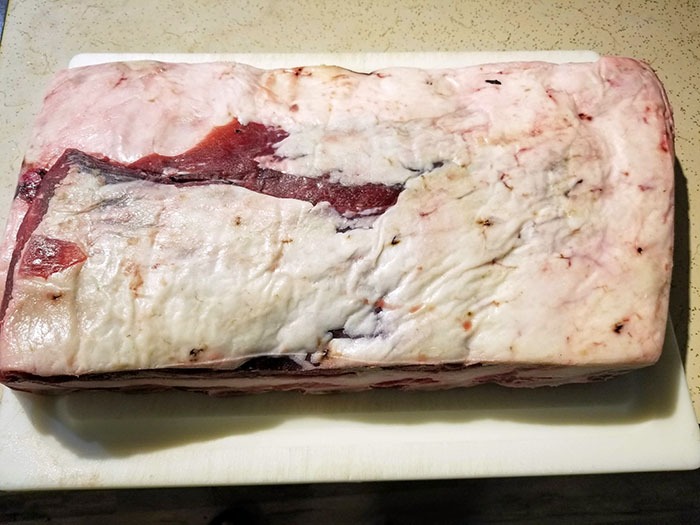
BTW, if y'all don't want to read 2300 words on how to melt beef ribs on a Weber Kettle allow me boil it downward:
- Purchase and prep your meat
- Cook your meat
- Eat your meat
Each of these steps tin go dozens of dissimilar ways. Some of them are wrong, well-nigh are just different from what I do, and some of them will exist improve. Since I haven't plant "better" nonetheless you just get to read what I exercise and how I do it. Want more details?
Showtime off, let'south start with the ribs themselves. To a higher place is a movie of the ribs that are currently cooking every bit I blazon this. I will exist adding to this post throughout the day and tonight afterward they are done cooking. So kind of a live weblog and kind of a random mind dump as issues come up up during the cook.
Anyhow, most beef ribs are either 3 bone Plate Ribs (from bones 6, seven, and eight) or iv bone Chuck Ribs (from bones 2, 3, four, and 5). I prefer plate ribs since they are a bit larger and have a bit more meat but if all you can get is chuck ribs that is fine too. These "dino ribs" above are from Porter Route and are 6 bones! I take never seen these cut like this. They weigh 9.36 pounds which is shut to the size of two normal racks. They are simply bachelor for a limited fourth dimension (and might already exist sold out) only you can put your proper name on a waiting list and be notified when they are back in stock. And if you use code MEATLOVER you tin relieve $fifteen on orders over $100 if you lot are a first time customer.
Serpent River Farms likewise sells racks of American Wagyu plate ribs (3 bone) that weigh in around vii pounds for $125. I accept never cooked that particular cutting from Serpent River simply I can only imagine it would be transcendent.
Since beef ribs like this have a lot of fatty and connective tissue they tin handle a bit more than estrus than some other cuts. My plan for these ribs was to melt them at 275 degrees for 8 hours. We all know plans like these can go many dissimilar directions only I always similar starting with a programme.
I am cooking these ribs on my Weber 26 inch kettle with the Slow N Sear. At some point I will upgrade to the Dull N Sear Forty which is designed for the 26 inch kettle but for at present the 22 inch version works but fine. I lit about a dozen Weber Charcoal briquettes, put them on one side of the SNS, then filled the residue with unlit charcoal. This should go me viii hours but I can e'er add another handful or two of briquettes at the end if I need to.
For beef I like to use oak wood. Oak smoke gives a not bad season to the beefiness and is a bit stronger than woods similar apple or pecan. I put a couple chunks of oak (simply a pocketbook of wood chunks from Domicile Depot) below the coals and three more on top. That will provide plenty of smoke for 2-3 hours which is almost all the meat will accept.
I like to flavour my beefiness ribs like I do brisket then that means common salt and pepper. I similar to rub a bit of Frank'south Ruby-red Hot on the ribs to become the seasoning to stick but you can utilize mustard or fifty-fifty only h2o for that if y'all need to. The salt went on the night before and I dry out brined them in the refrigerator overnight. This morn earlier I put them on the grill I slathered them in the hot sauce and then on went the pepper. All in all it was probably 1/3 cup of coarse ground pepper but since I didn't actually measure it that is a guess.
Before I put the ribs on the cooker I filled the water trough in the SNS with hot h2o and put a bit of water in some disposable aluminum pans underneath the meat. The pans are mostly just to catch whatsoever drippings merely the extra steam also helps go on the meat moist.
One time the kettle got up to about 225 degrees or and then I put the ribs on. All the temperatures are monitored with my Thermoworks Smoke thermometer. I beloved this thermometer because information technology is accurate, precise, easy to use, durable, and with the remote unit I tin be down in my office working and still proceed rail of the meat and grill temperatures. If you plan on smoking anything I couldn't recommend this thermometer more than. In a perfect world I would just exist sitting out on the patio past the smoker with a cool beverage in my paw merely this is real life. Other things demand to go done.
After 2 hours the temp of the ribs was already up to 125 degrees and here is what they looked like:
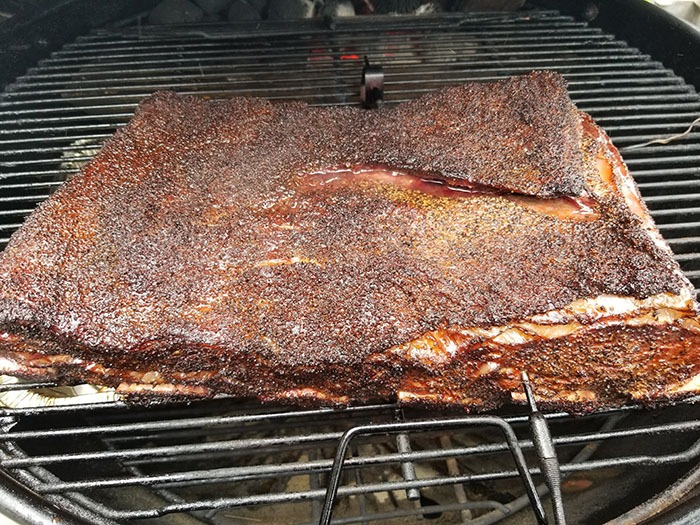
Subsequently two or iii hours cooking I similar to showtime spritzing the meat. About of the time I just utilise apple juice. Since I have kids I nigh always have some apple juice in the refrigerator. I accept even been known to steal a couple of their juice boxes and dump them in my spray canteen. Experience free to use apple cider vinegar or most whatever other liquid for this. Or skip information technology all together. I think spritzing keeps the exterior from drying out too much but it will slow down the cook but slightly. I usually spritz every hour or two or whenever I go take a look at the kettle.
You lot tin see they are starting to pull back on the bones and they are taking on some practiced colour. After 5 hours they were at 175. Not sure if the stall is coming later or if I only powered through it. I am guessing I just powered through it. Usually when cooking at 275 as opposed to 225 the stall is either much shorter or non-real.
What is the stall? When yous are smoking a large hunk of meat at somewhere between 140-170 degrees requite or take a few you will detect that the temperature of the meat stalls. This happens because of moisture evaporation. The stall can take hours on some pieces of meat and become very apace on others. I unremarkably just permit things ride only if you are stalled in that location are generally two ways to speed things up: Wrap or increase the temps.
BTW, you will notice I employ a lot of cryptic terms similar "usually" or "generally". This is considering every piece of meat cooks different.
Wrapping: If your meat is stalled you can choose to wrap your meat in foil or peach butcher paper. I definitely prefer butcher paper for this as it still allows the meat to breathe a bit. In foil you lot are basically steaming the meat and I think, peculiarly for brisket and beefiness ribs, it makes information technology as well much like a pot roast. With paper yous still preserve some of the peachy bark of the meat. Me personally? I don't wrap most of the time and if I do it is later on the stall. I similar the bark on my meat and I think you lot give some of that upward if y'all wrap earlier the stall. Simply many times I volition just forgo wrapping until the meat is done.
Increase the temps: If you are cooking at 225 and y'all stall out bump up your temps to 250 or 275. The stall volition still happen simply boosting the temps will speed it up.
When you do hit the stall don't panic! Many people will start getting a bit fidgity when the stall hits. Unless you are in a huge time crisis simply remain calm, crack open some other beer, and ride it out.
At the time of this writing I am 5 1/2 hours in and sitting at 182 degrees. I am nevertheless debating on if I want to wrap the ribs or only allow them continue going. They are on stride to be done in time so I am in no real hurry and so I am leaning confronting wrapping merely I could change my mind.
Let's talk for a minute almost "washed in time"… Dinner is at 6 tonight. If I cease the ribs at 6, pull them off, and slice them up that will be doing a disservice to the ribs. I similar to permit them rest for at least 2 hours before eating. When I rest them I wrap them in butcher paper and then some heavy towels and put them in a cooler. This can continue the meat above serving temperature (140 degrees) for at least 6 hours. So when planning a cook I like to shoot to have the meat off the grill about 3 hours earlier eating. If things stop early that is fine and if fourth dimension is getting tight I will still take plenty of buffer. I got this rack started virtually an hr subsequently than I wanted but will still take plenty of time before information technology is time to eat.
Later vi hours these ribs are looking astonishing:

They are actually starting to pull back on the os, the bawl is looking great, and the fat is rendering nicely. So far I am very happy with how this melt is going.
Here is what the Slow N Sear looks like after half-dozen hours. There is still quite a flake more than heat left in these dress-down but I threw some foil over the ribs to protect them from any ash, knocked down the coals, and added a couple more handfuls. I might have gotten abroad without doing this only a few actress coals wouldn't injure anyone.
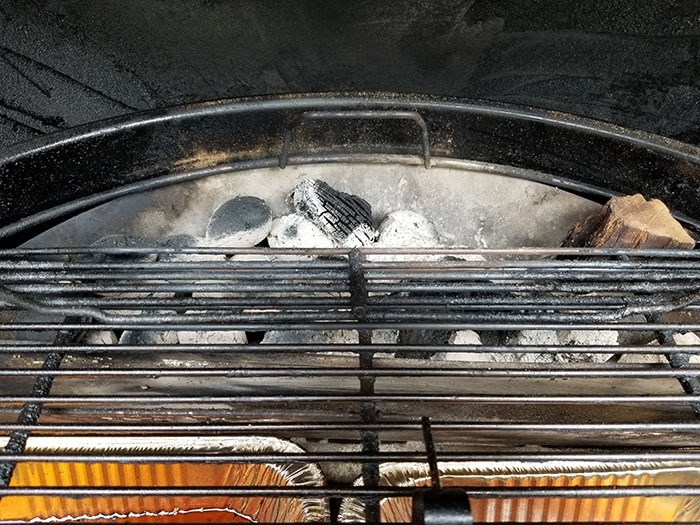
It is getting close to the ribs existence done. Temperature-wise yous want them somewhere in the 195-205 degree range. Once more, that will vary with each rack of beef ribs. When you stick a toothpick, skewer, or probe thermometer in you lot should feel very footling resistance in the meat. Equally you stick your probe down betwixt the bones there is a membrane down at that place. When the ribs are done you should be able to go through it with only a slight bit or resistance. I checked these just for fun and they need a bit more.
Afterward another hour and a half (7 one/two hours total) these ribs were done. They were at right nigh 198 degrees and the probe went through them very easily. I checked a few different spots on the rack to make sure and everything felt super tender.
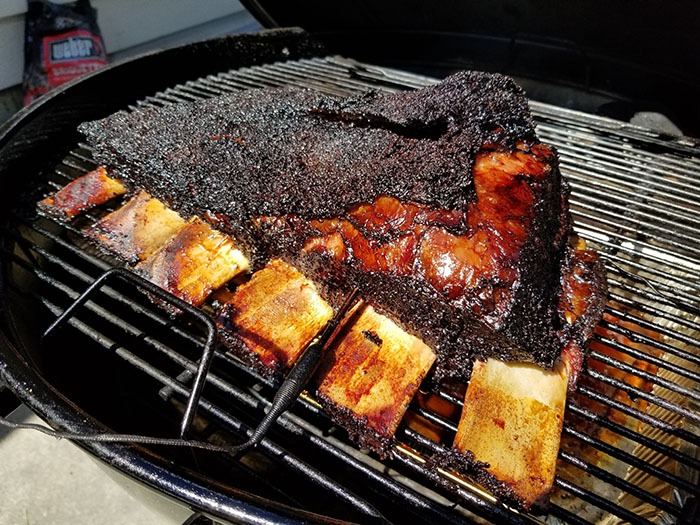
I dear the fashion these looked at the stop of this cook. The bark was nice and black, the ribs had pulled way dorsum on the os, and the fat was rendered nicely. The next 2 ane/two hours until dinner was going to be a LONG look.
The ribs came off the cooker, I wrapped them in peach paper, and so put them in the cooler with some big, heavy towels around them. Pro Tip: Don't utilize your wife's good towels for this. The smell of smoked meat will never come out of them. I take about vi towels specifically for this purpose that I keep with my cooking gear. Wrapped up like this these could accept stayed warm well over 5 or half dozen hours.
Now it is time to slice and eat! I use a 12 inch Dexter slicing knife to piece stuff like ribs and brisket. These knives are wicked precipitous and are inexpensive enough that you tin can replace them after a few years if needed. There isn't much of a trick to slicing. Just cut between each os and you will exist good to get.
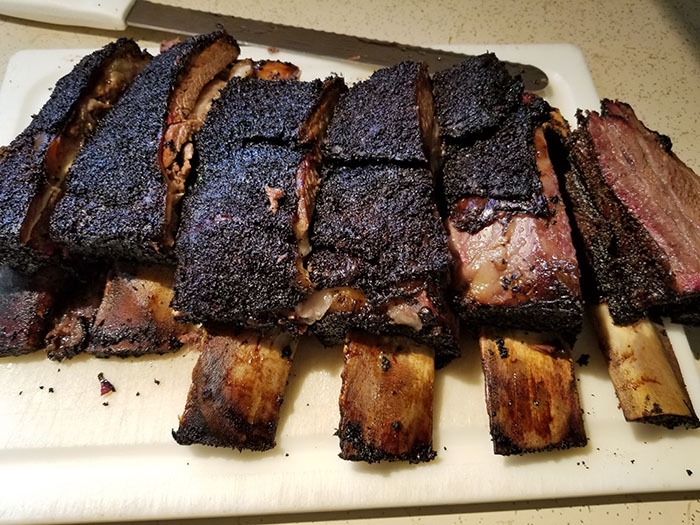
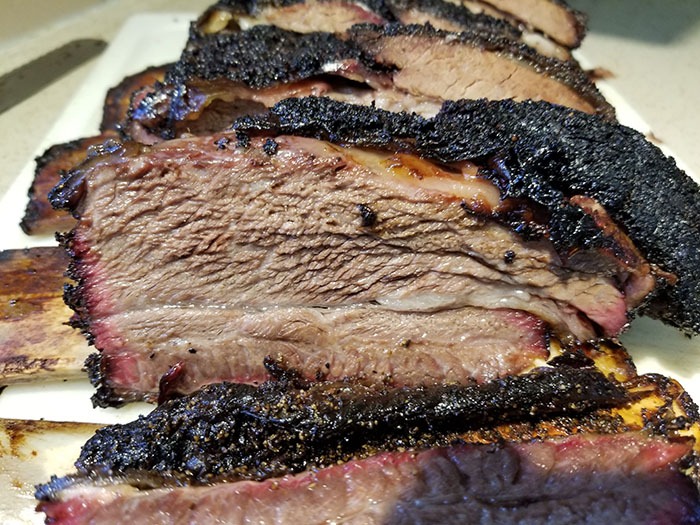
All in all I was VERY happy with how this cook went. I was able to proceed some steady temperatures the whole time, the ribs finished within thirty minutes of my goal, the bark ready nicely, and the meat was super tender and juicy. Does that mean everything went perfectly? Of course not. Hither are a few things I learned or would do differently adjacent time:
- Dry alkali earlier – I was only able to become almost a 9 hour dry out brine on these ribs. When I took them out of the refrigerator in the morn the salt was still sitting on the fatty cap and didn't have a chance to penetrate the meat. If it was but meat it would have been fine but it seems like the common salt takes a bit longer to penetrate the fat. Another day or so would have been great. A bit more pepper might have been nice besides.
- Trim a bit more fat – These ribs came out of the package looking great with no weird pieces hanging off that needed to be trimmed. I thought the fat cap might have been a bit too thick but decided to roll with it. Looking dorsum I wish I would accept shaved information technology downwardly always so slightly.
- Large vein of fatty – This particular rack of ribs had a fairly big vein of fatty running through information technology. The rib to a higher place is pretty much perfect merely a couple others further down the rack ended up with a very thick piece of fat in the middle. Not much could have been done nigh this and every rack will be dissimilar but that much fat made some of the ribs a flake tricky to eat.
- Wrap them earlier – Like I mentioned earlier, I tend to not wrap anything. But the terminal brisket I did I wrapped later the stall (about 180) and information technology was ane of the best briskets I have ever made. I kind of wish I would have washed that with these ribs to slightly soften the bark.
If you have never tried beefiness ribs on your Weber Kettle (or whatever smoker yous have) I would highly recommend them. Option up a rack from Porter Road or Ophidian River Farms or find them at your local butcher and requite them a get.
Source: https://completecarnivore.com/how-to-make-beef-ribs-on-the-weber-kettle/
Post a Comment for "Beef Ribs on the Weber Kettle"